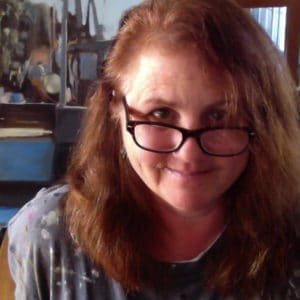
When painter Donna Lee Nyzio turned 50, she decided to make art the main source of her income. In 2017, she was selected to be a CHF Accelerator Fellow and progressed to a senior-level Fellowship the following year. Although she graduated last December, she remains actively involved with our program as a Fellow Advisor, working with the current class of artists.
Based in the coastal town of Beaufort, North Carolina, Donna captures and preserves the maritime history of the eastern seaboard, whose images come alive in her work. Here, she shares some thoughts on her time as a CHF Fellow.
On creating a career plan…
Because I am entering the art market so late in life, I have to work smart and hard. CHF helped me to refine my goals—plotting them on paper and creating a “blueprint” for my path. I considered how I want to fit into the art world, researched who my clients are, and decided that the best way for me to build my audience was to stay true to my style. I now use my strengths to their limit, then push them further. I have improved on some weaknesses, and some I have just kicked to the curb; I build a workaround and keep on moving. Having a monthly production schedule allows me to hit my marks, and manage my time and money almost a year in advance.
On sales strategy…
For the purposes of selling, I consider my work to be a product—not like something on Wayfair, but more of a luxury item. Luxury items aren’t sold based on the lowest price or fastest shipping, but rather on the relationship between artist and viewer. I have strong partnerships with galleries that align with my sales strategies and goals. I ask for their input on successful pricing and presentation, and I also say, “Hey, I have an idea! Let’s try something new.”

On marketing and relationship-building…
I help museums and community groups understand what it means to work with an artist, instead of seeing us the source of in-kind donations. Building relationships with other professional artists—networking and learning from their successes and failures—is also amazingly helpful. Rather than focusing on social media, I prefer the deeper professional relationships you can create in person. I spend my time educating people at exhibitions and events, and traveling to areas I find interesting. Often, I am educated as well! My connections are deeper and longer-lasting as a result; they grow as I grow.
On finding her place within her local community…
Beaufort is small, fewer than 5,000 people. People come here to retire and downsize, and we get a burst of people in the summer, but neither scenario translates to consistent sales of fine art. My clients are a great distance away, but my community is here, so I have to have two totally different approaches. I can be found around town—usually in my painting clothes and with my easel—and spend time talking to travelers and locals alike and getting involved in town events. The focus on my maritime surroundings keeps me connected to our North Carolina Maritime Museum, and we partner to educate, preserve, and grow an interest in the community of working watermen that once thrived here. I have taken the time to help folks see that art as a business, not a hobby, and now I’m seen as a entrepreneur.
On what she’s learned about herself…
Being an artist is like being a piece of a puzzle. The trick is to find the puzzle where your piece belongs. The art industry creates many types of theories, gimmicks, and labels for artists; the trick is to shut out the noise. YOU decide where you fit, based on your goals and skills, what you want accomplish, and how you want to work. When you define your answers, wow, it all becomes clear, just like a finished puzzle that was once a bunch of scattered pieces on the table.
On why she decided to stay on with CHF and serve as an Accelerator Fellow Advisor…
The best way to learn is to teach someone else. When you answer questions or provide advice, you gain clarity and see the same issue differently. I get to develop new insights into the work of being an artist, and I also get the joy of helping others move toward their goals and dreams. As I talk to these artists, I realize how far I have come in my two years as a CHF Fellow and how far I still need to go. These artists are making their paths, and it is exciting to watch them soak up the information and reach those “a-ha!” moments for themselves.




Donna, I admire you for finding your niche market in maritime art, and greatly enjoyed your CHF podcast interview. My two areas of art are also small, and I previously thought of that as a disadvantage. Through listening to you, I learned to think of them as a specialty, a niche. Now I have to develop a strategy to have them recognized as special–expressive portraits that come to life in pastel. Thanks!